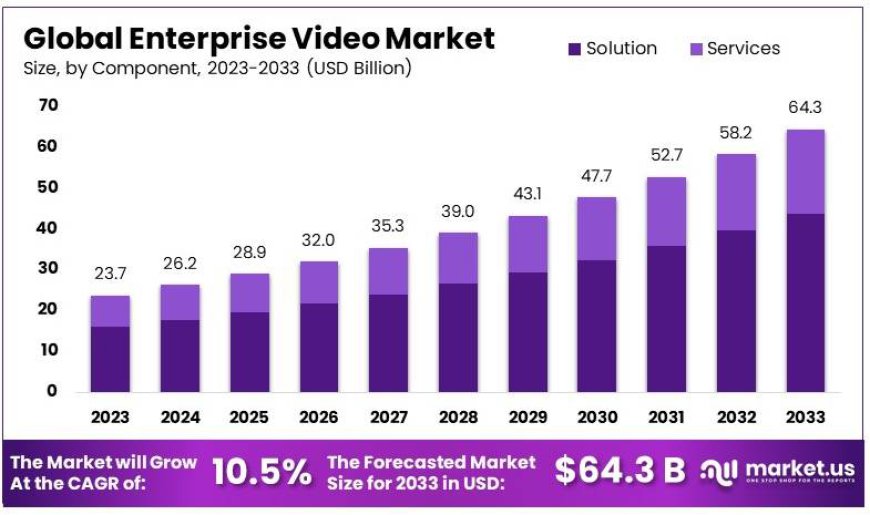Enterprise Video Market Evolution: From Basic Conferencing to Immersive Experiences
The Enterprise Video Market involves the creation, management, and distribution of video content within organizations. This market encompasses tools and platforms that enable businesses to use video for internal communication, training, marketing, and customer engagement.

The Enterprise Video Market encompasses the range of video technologies and solutions used by businesses to enhance communication, collaboration, and training. With the increasing importance of visual communication in today's fast-paced business environment, enterprise video solutions have become crucial for organizations of all sizes. These tools facilitate everything from video conferencing and webinars to live streaming and training sessions, helping companies stay connected and productive.The Global Enterprise Video Market size is expected to be worth around USD 64.3 Billion by 2033, from USD 23.7 Billion in 2023, growing at a CAGR of 10.5% during the forecast period from 2024 to 2033.
Growth Factors
Several factors are driving the growth of the enterprise video market. The rise of remote work has significantly increased the demand for video conferencing tools, as businesses seek effective ways to maintain communication with distributed teams. Additionally, advancements in technology, such as high-speed internet and powerful video processing capabilities, have made high-quality video more accessible and affordable. The need for enhanced collaboration and engagement in meetings and training sessions is also fueling the adoption of video solutions across various industries.
Read More @https://market.us/report/enterprise-video-market/
Emerging Trends
The enterprise video market is experiencing several exciting trends. One major trend is the integration of artificial intelligence (AI) and machine learning, which enhance video quality and offer features like real-time translation and automated transcription. Another trend is the rise of immersive technologies, such as virtual reality (VR) and augmented reality (AR), which are transforming traditional video experiences into more interactive and engaging sessions. Additionally, the growing emphasis on cybersecurity is leading to the development of more secure video platforms to protect sensitive business information.
Top Use Cases
Enterprise video solutions are used in a variety of ways. One of the top use cases is video conferencing, which enables teams to hold meetings and collaborate remotely, reducing the need for travel and saving time. Another key use case is training and development, where companies use video to deliver instructional content, conduct workshops, and support employee learning. Additionally, live streaming of events, such as company announcements or product launches, allows businesses to reach a larger audience and engage with customers in real-time.
Challenges
Despite its benefits, the enterprise video market faces several challenges. One major issue is the complexity of integrating video solutions with existing IT systems and workflows. Companies often struggle with ensuring compatibility and managing multiple video platforms. Another challenge is maintaining video quality and reliability, especially in areas with unstable internet connections. Security concerns also pose a risk, as businesses must protect their video communications from potential breaches and unauthorized access.
Opportunities
There are significant opportunities within the enterprise video market. As technology continues to advance, companies can leverage new innovations to enhance their video solutions and offer more value to users. The growing popularity of hybrid work models creates opportunities for video providers to develop tools that facilitate seamless collaboration between remote and in-office teams. Additionally, the expansion of global markets presents opportunities for video solutions to cater to diverse needs and preferences across different regions.
Conclusion
In conclusion, the Enterprise Video Market is evolving rapidly, driven by advancements in technology and the growing need for effective communication in a digital world. While there are challenges to overcome, such as integration and security concerns, the opportunities for innovation and growth are substantial. As businesses continue to adapt to changing work environments and seek new ways to engage with their teams and customers, the role of enterprise video solutions will only become more central to their success.
